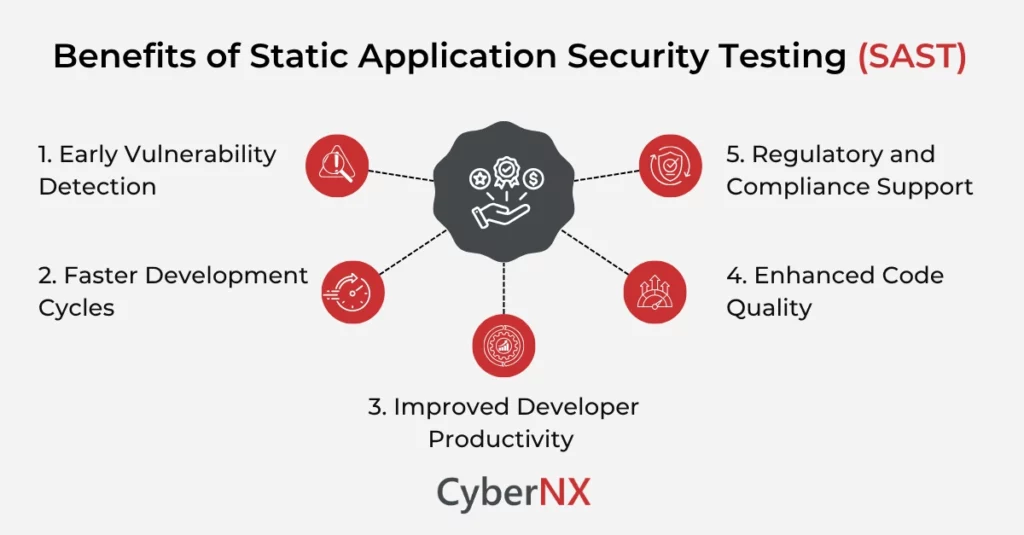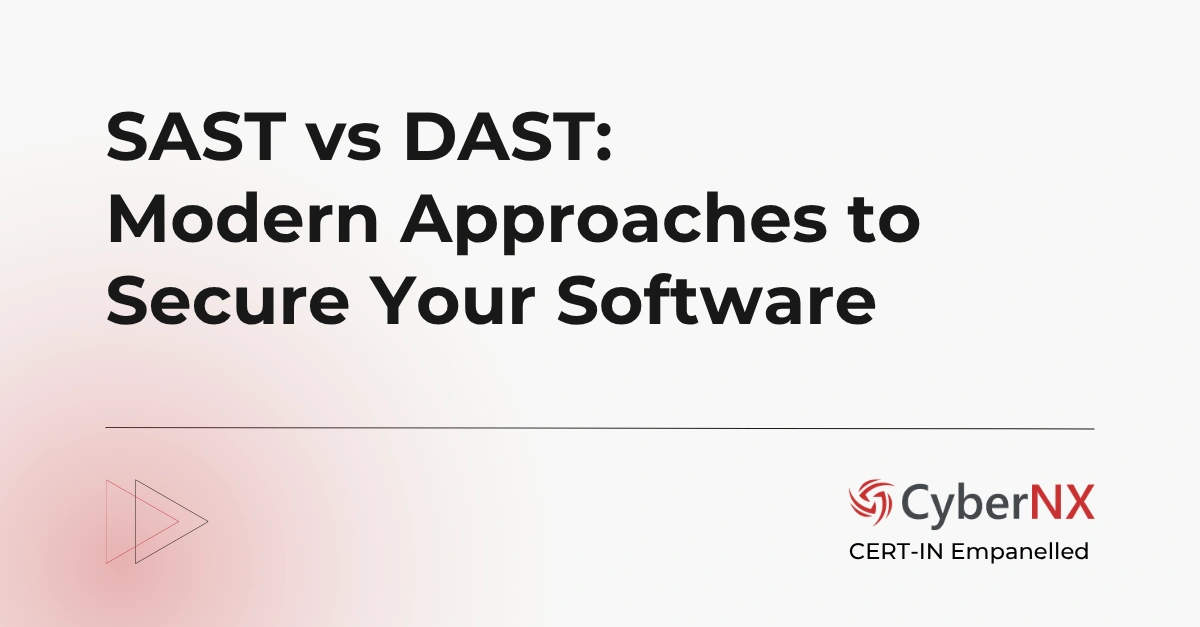Software is ingrained in everything that we do today. Every industry utilizes software for seamless operations and optimized performance. But what if a possible data breach lurks in your source code used in software applications? That’s quite a big risk.
A recent report by Veracode reveals that 76% of apps have at least one security flaw, and many of them are introduced in the coding phase.
That’s why Static Application Security Testing (SAST) has emerged as a key solution. It helps in finding and fixing vulnerabilities at the source—your source code. Such application code analysis before execution enables teams to detect issues early, reduce costs and improve security outcomes.
Understanding Static Application Security Testing
Static Application Security Testing (SAST) can be understood as a testing method that scans application source code, bytecode and binaries. The goal is to uncover security vulnerabilities that could attract potential cyberattacks. This analysis is done before the program is executed or the code is compiled.
SAST is often called white box testing because testers have full visibility into the code’s structure, control flow and logic.
To give more of a technical context, SAST tools find vulnerabilities such as buffer overflows, injection flaws, authentication bypasses and insecure data handling. The flaws are mapped to recognized and accepted industry standards like the OWASP Top 10, CWE and CERT.
Now that you know what is SAST in cyber security, the next obvious question that you might have will be – how is it different from Dynamic Application Security Testing (DAST).
SAST analyses source code early in the SDLC, whereas DAST evaluates the application from an external point of view while it’s running.
SAST is integrated early in the software development cycle, enabling development teams to fix any issues before they could blow out of proportion and cause irreversible damage to businesses.
Static Application Security Testing in the Software Development Lifecycle (SDLC)
Ask any security expert and they will say Static Application Security Testing works best when it is embedded directly into the SDLC. Not when forced after development is done.
Moreover, our experts believe that in the modern DevSecOps environment, there is a growing emphasis on “shifting security left.” It means integrating security controls early and SAST is central to this shift. Find out more below.
1. Requirement and Design Phase
In this phase, security teams define coding standards and choose SAST tools according to the languages and frameworks. SAST tools are integrated into IDEs like Visual Studio Code, helping developers receive feedback in real-time as they go on coding.
How it helps is that vulnerabilities are flagged and resolved without waiting for QA cycles.
2. Build and Integration Phase
SAST tools run automatically within CI/CD pipelines in this phase. This, in turn, ensures that code meets security standards before it is deployed. Tools like Jenkins and Azure DevOps are used for automated scans.
3. Testing Phase
During this phase, findings after carrying out SAST are triaged with QA bugs. Development and security teams get on the table to fix high-severity issues before release, together. Metrics from the scans are fed into dashboards, tracking security debt and resolution trends.
4. Maintenance Phase
In the maintenance phase, the SAST team ensures that fresh code changes do not reintroduce vulnerabilities. Legacy systems and third-party components are scanned, keeping the codebase secure as it evolves.
As you can see, SAST testing at each SDLC phase is a business enabler rather than a bottleneck.
5 Benefits of Static Application Security Testing
Catching vulnerabilities? Is that it about SAST? No. It helps in aligning development, security and business goals by ushering in a culture of secure development. Find our other benefits below.
1. Early Vulnerability Detection
SAST helps development teams to identify vulnerabilities early in the development process. Keep in mind, this is the stage where they are easiest and cheapest to fix.
As per a report from IBM, vulnerabilities discovered during production cost more than 15 times as much to fix compared to those found during development. So, SAST reduces costs by identifying issues pre-deployment.
2. Faster Development Cycles
Integrating security right into the developer’s environment helps resolve issues in real time. You see the issue; you solve the issue. This ensures you have to deal with lesser security-related delays at the end of a release cycle.
3. Improved Developer Productivity
Developers also benefit from SAST. They learn about secure coding practices through SAST tools, which often provide clear, understandable, contextual explanations and remediation guidance. This essentially speeds up learning curves and reduces dependency on AppSec teams.
4. Enhanced Code Quality
Many of the SAST tools also work as code quality checkers. Therefore, they enforce security standards and best coding practices, improving maintainability and performance.
5. Regulatory and Compliance Support
SAST helps organizations demonstrate adherence to security and privacy regulations like PCI-DSS, HIPAA, GDPR and ISO 27001. SAST tools generate automated reports, which serve as evidence for audits. Plus, it promotes customer assurance.
Additionally, SAST identifies and categorizes vulnerabilities based on severity and exploitability. Based on this, organizations focus on remediation efforts which matter most. In short, you achieve smarter resource allocation and a lower overall risk profile.
Implementing Static Application Security Testing: Key Steps
Implementing Static Application Security Testing strategically is key to extracting maximum benefit from it. Find key steps to do it effectively:
1. Assess the Environment and Stack
Evaluate the programming languages, frameworks and development tools used in your organization – that’s the first step. Then, choose a SAST tool that integrates well with your current environment.
2. Define Security Policies and Coding Standards
Establish baseline coding rules and compliance objectives before opting for SAST scanning. What it does is help maintain consistency and alignment with scanning results related to your business risk priorities.
3. Selecting a SAST Tool
All SAST tools have different capabilities. Thus, you should evaluate things such as scan speed, language support, false-positive rates and integration capabilities. If you are still unsure, consult with security experts.
4. Integrate with Developer Workflows
Integrating SAST scans into IDEs and CI/CD pipelines is important. As discussed before, this will enable your developer team to receive valuable feedback as part of their existing processes without slowing them down.
5. Train Developers
Conduct training and regular workshops. Provide secure coding playbooks to help developers understand how to fix issues flagged by the tool. A well-trained development team is critical.
6. Track Metrics and Improve Continuously
You should monitor KPIs like average time to remediate, number of vulnerabilities introduced per release and reduction in high-severity issues over time. Use this data to improve training and development practices.
Tools Used in Static Application Security Testing
Choosing the right tools for SAST implementation can be complex. Here we have listed some of the widely used and trusted tools for you:
- SonarQube: Available in both open-source and enterprise versions, this SAST tool is suitable for integrating quality and security checks.
- Checkmarx: It is an enterprise-grade solution, well-known for deep code analysis and DevSecOps integration.
- Veracode: A cloud-native platform, the tool comes with pre-built CI/CD connectors and policy management.
- Fortify Static Code Analyzer: Customization option in this tool makes it suitable for large, regulated enterprises.
- CodeQL: It is GitHub’s query-based analysis engine, used mainly for open-source and enterprise environments.
SAST tools, a majority of them, offer dashboards, APIs, IDE plugins and automated reporting to support security workflows at scale.
Conclusion
Static Application Security Testing quite efficiently hardens your software at the source. It empowers developers, improves code quality, accelerates development and safeguards your brand.
SAST is a strategy—one that forward-looking IT leaders are embracing to build secure, scalable and resilient digital products.
If you are into building software, it’s high time to make SAST a permanent part of your development DNA.
We are a leading CERT-In Empanelled security testing company with qualified experts, deep industry experience, and advanced tools. Our Source Code Review (SCR) service uncovers hidden vulnerabilities in your application’s code early in the development cycle. Along with SAST and other security services, we help clients across India and globally build secure, reliable digital products. Contact us today to learn more about how our SCR service can enhance your application security.
Static Application Security Testing FAQs
Can SAST be used for third-party or open-source components?
While SAST is primarily designed for proprietary source code, it can also be applied to some open-source components if the source is available. However, for better coverage of third-party risks, combining SAST with Software Composition Analysis (SCA) is recommended.
How frequently should Static Application Security Testing scans be performed?
Ideally, SAST scans should be automated and performed on every code commit or pull request. At a minimum, they should run before each major release to catch vulnerabilities introduced during development.
Does Static Application Security Testing slow down the development process?
Not if implemented correctly. Modern SAST tools offer fast, incremental scanning and can be integrated into IDEs and CI/CD pipelines. This allows developers to fix issues in real time without delaying releases.
How do you measure the ROI of SAST implementation?
Key metrics include the reduction in vulnerabilities over time, mean time to remediate, developer adoption rates, fewer production incidents, and improved compliance posture. Comparing pre- and post-SAST breach costs also highlights its ROI.


